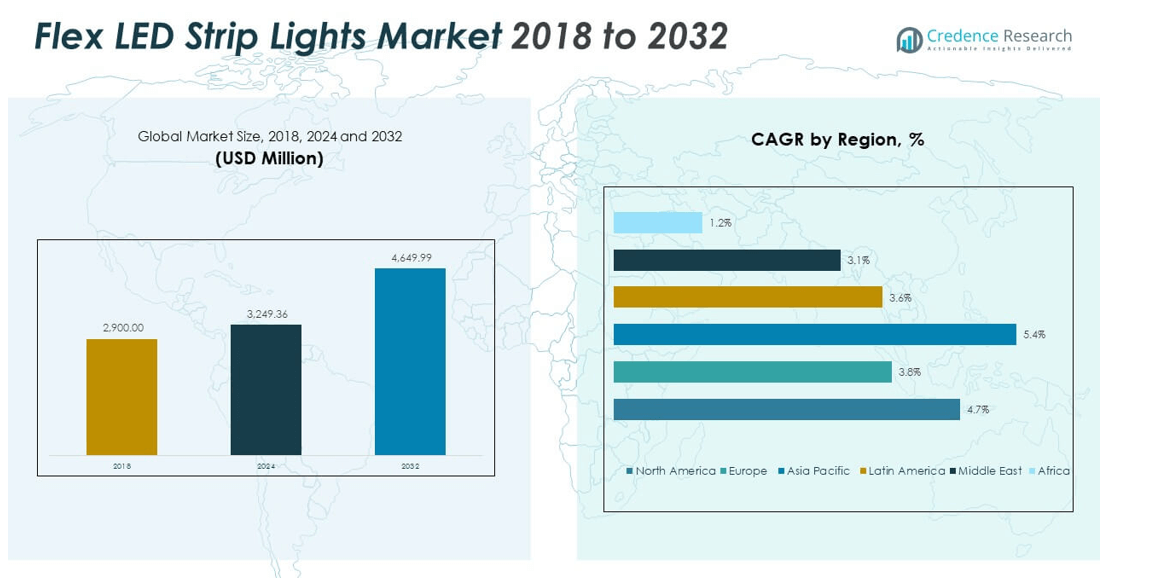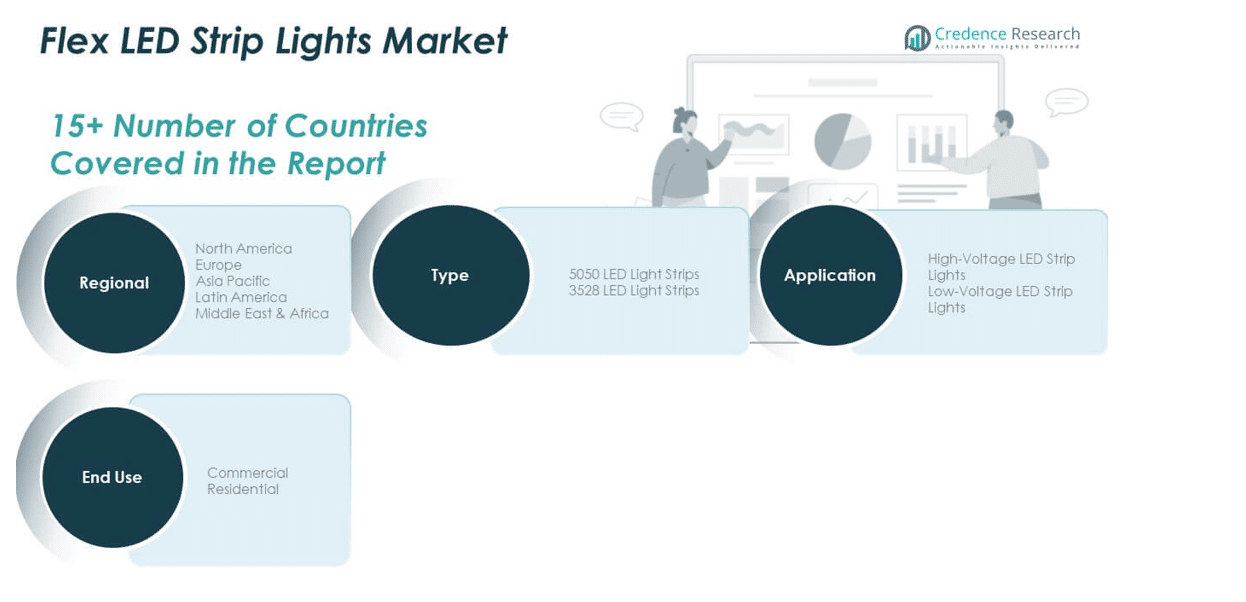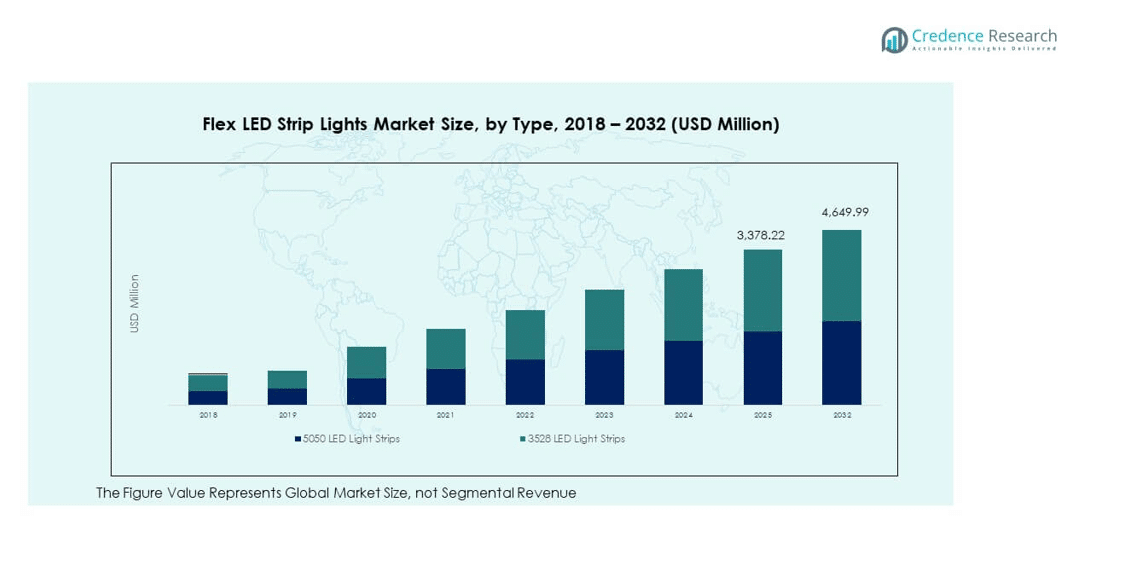CHAPTER NO. 1 : INTRODUCTION 26
1.1. Report Description 26
Purpose of the Report 26
USP & Key Offerings 26
1.2. Key Benefits for Stakeholders 27
1.3. Target Audience 27
CHAPTER NO. 2 : EXECUTIVE SUMMARY 28
CHAPTER NO. 3 : FLEX LED STRIP LIGHTS MARKET FORCES & INDUSTRY PULSE 30
3.1. Foundations of Change – Market Overview 30
3.2. Catalysts of Expansion – Key Market Drivers 32
3.3. Momentum Boosters – Growth Triggers 33
3.4. Innovation Fuel – Disruptive Technologies 33
3.5. Headwinds & Crosswinds – Market Restraints 34
3.6. Regulatory Tides – Compliance Challenges 35
3.7. Economic Frictions – Inflationary Pressures 35
3.8. Untapped Horizons – Growth Potential & Opportunities and Strategic Navigation – Industry Frameworks 36
3.9. Market Equilibrium – Porter’s Five Forces 37
3.10. Ecosystem Dynamics – Value Chain Analysis 39
3.11. Macro Forces – PESTEL Breakdown 41
CHAPTER NO. 4 : COMPETITION ANALYSIS 43
4.1. Company Market Share Analysis 43
4.1.1. Global Flex LED Strip Lights Market Company Revenue Market Share 43
4.2. Strategic Developments 45
4.2.1. Acquisitions & Mergers 45
4.2.2. New Type Launch 46
4.2.3. Agreements & Collaborations 47
4.3. Competitive Dashboard 48
4.4. Company Assessment Metrics, 2024 49
CHAPTER NO. 5 : GLOBAL MARKET ANALYSIS, INSIGHTS & FORECAST, BY TYPE 50
CHAPTER NO. 6 : GLOBAL MARKET ANALYSIS, INSIGHTS & FORECAST, BY APPLICATION 54
CHAPTER NO. 7 : GLOBAL MARKET ANALYSIS, INSIGHTS & FORECAST, BY END-USE 58
CHAPTER NO. 8 : GLOBAL MARKET ANALYSIS, INSIGHTS & FORECAST, BY REGION 62
CHAPTER NO. 9 : NORTH AMERICA MARKET ANALYSIS, INSIGHTS & FORECAST, BY COUNTRY 67
9.1. North America Market Analysis, Insights & Forecast, by Type 69
9.2. North America Market Analysis, Insights & Forecast, by Application 70
9.3. North America Market Analysis, Insights & Forecast, by End-use 71
CHAPTER NO. 10 : EUROPE MARKET ANALYSIS, INSIGHTS & FORECAST, BY COUNTRY 72
10.1. Europe Market Analysis, Insights & Forecast, by Type 75
10.2. Europe Market Analysis, Insights & Forecast, by Application 76
10.3. Europe Market Analysis, Insights & Forecast, by End-use 77
CHAPTER NO. 11 : ASIA PACIFIC MARKET ANALYSIS, INSIGHTS & FORECAST, BY COUNTRY 78
11.1. Asia Pacific Market Analysis, Insights & Forecast, by Type 81
11.2. Asia Pacific Market Analysis, Insights & Forecast, by Application 82
11.3. Asia Pacific Market Analysis, Insights & Forecast, by End-use 83
CHAPTER NO. 12 : LATIN AMERICA MARKET ANALYSIS, INSIGHTS & FORECAST, BY COUNTRY 84
12.1. Latin America Market Analysis, Insights & Forecast, by Type 87
12.2. Latin America Market Analysis, Insights & Forecast, by Application 88
12.3. Latin America Market Analysis, Insights & Forecast, by End-use 89
CHAPTER NO. 13 : MIDDLE EAST MARKET ANALYSIS, INSIGHTS & FORECAST, BY COUNTRY 90
13.1. Middle East Market Analysis, Insights & Forecast, by Type 93
13.2. Middle East Market Analysis, Insights & Forecast, by Application 94
13.3. Middle East Market Analysis, Insights & Forecast, by End-use 95
CHAPTER NO. 14 : AFRICA MARKET ANALYSIS, INSIGHTS & FORECAST, BY COUNTRY 96
14.1. Africa Market Analysis, Insights & Forecast, by Type 99
14.2. Africa Market Analysis, Insights & Forecast, by Application 100
14.3. Africa Market Analysis, Insights & Forecast, by End-use 101
CHAPTER NO. 15 : COMPANY PROFILE 102
15.1. General Electric Company 102
15.2. Nexlux 105
15.3. HitLights 105
15.4. EnvironmentalLights.com 105
15.5. Foshan Lighting 105
15.6. OSRAM 105
15.7. SIRS-E 105
15.8. LEONLITE 105
15.9. Company 9 105
15.10. Company 10 105
15.11. Company 11 105
15.12. Company 12 105
15.13. Company 13 105
15.14. Company 14 105
List of Figures
FIG NO. 1. Flex LED Strip Lights Market Revenue Share, By Type, 2024 & 2032 50
FIG NO. 2. Market Attractiveness Analysis, By Type 51
FIG NO. 3. Incremental Revenue Growth Opportunity by Type, 2024 – 2032 52
FIG NO. 4. Flex LED Strip Lights Market Revenue Share, By Application, 2024 & 2032 54
FIG NO. 5. Incremental Revenue Growth Opportunity by Application, 2024 – 2032 55
FIG NO. 6. Incremental Revenue Growth Opportunity by Application, 2024 – 2032 56
FIG NO. 7. Flex LED Strip Lights Market Revenue Share, By End-user, 2024 & 2032 58
FIG NO. 8. Market Attractiveness Analysis, By End-user 59
FIG NO. 9. Incremental Revenue Growth Opportunity by End-use, 2024 – 2032 60
FIG NO. 10. Flex LED Strip Lights Market Revenue Share, By Region, 2024 & 2032 62
FIG NO. 11. Market Attractiveness Analysis, By Region 63
FIG NO. 12. Incremental Revenue Growth Opportunity by Region, 2024 – 2032 64
FIG NO. 13. Flex LED Strip Lights Market Revenue Share, By Country, 2024 & 2032 67
FIG NO. 14. Flex LED Strip Lights Market Revenue Share, By Country, 2024 & 2032 72
FIG NO. 15. Flex LED Strip Lights Market Revenue Share, By Country, 2024 & 2032 78
FIG NO. 16. Flex LED Strip Lights Market Revenue Share, By Country, 2024 & 2032 84
FIG NO. 17. Flex LED Strip Lights Market Revenue Share, By Country, 2024 & 2032 90
FIG NO. 18. Flex LED Strip Lights Market Revenue Share, By Country, 2024 & 2032 96
List of Tables
TABLE NO. 1. : Global Flex LED Strip Lights Market Revenue, By Type, 2018 – 2024 (USD Million) 53
TABLE NO. 2. : Global Flex LED Strip Lights Market Revenue, By Type, 2025 – 2032 (USD Million) 53
TABLE NO. 3. : Global Flex LED Strip Lights Market Revenue, By Application, 2018 – 2024 (USD Million) 57
TABLE NO. 4. : Global Flex LED Strip Lights Market Revenue, By Application, 2025 – 2032 (USD Million) 57
TABLE NO. 5. : Global Flex LED Strip Lights Market Revenue, By End-use, 2018 – 2024 (USD Million) 61
TABLE NO. 6. : Global Flex LED Strip Lights Market Revenue, By End-use, 2025 – 2032 (USD Million) 61
TABLE NO. 7. : Global Flex LED Strip Lights Market Revenue, By Region, 2018 – 2024 (USD Million) 65
TABLE NO. 8. : Global Flex LED Strip Lights Market Revenue, By Region, 2025– 2032 (USD Million) 66
TABLE NO. 9. : North America Flex LED Strip Lights Market Revenue, By Country, 2018 – 2024 (USD Million) 68
TABLE NO. 10. : North America Flex LED Strip Lights Market Revenue, By Country, 2025– 2032 (USD Million) 68
TABLE NO. 11. : North America Flex LED Strip Lights Market Revenue, By Type, 2018 – 2024 (USD Million) 69
TABLE NO. 12. : North America Flex LED Strip Lights Market Revenue, By Type, 2025 – 2032 (USD Million) 69
TABLE NO. 13. : North America Flex LED Strip Lights Market Revenue, By Application, 2018 – 2024 (USD Million) 70
TABLE NO. 14. : North America Flex LED Strip Lights Market Revenue, By Application, 2025 – 2032 (USD Million) 70
TABLE NO. 15. : North America Flex LED Strip Lights Market Revenue, By End-use, 2018 – 2024 (USD Million) 71
TABLE NO. 16. : North America Flex LED Strip Lights Market Revenue, By End-use, 2025 – 2032 (USD Million) 71
TABLE NO. 17. : Europe Flex LED Strip Lights Market Revenue, By Country, 2018 – 2024 (USD Million) 73
TABLE NO. 18. : Europe Flex LED Strip Lights Market Revenue, By Country, 2025– 2032 (USD Million) 74
TABLE NO. 19. : Europe Flex LED Strip Lights Market Revenue, By Type, 2018 – 2024 (USD Million) 75
TABLE NO. 20. : Europe Flex LED Strip Lights Market Revenue, By Type, 2025 – 2032 (USD Million) 75
TABLE NO. 21. : Europe Flex LED Strip Lights Market Revenue, By Application, 2018 – 2024 (USD Million) 76
TABLE NO. 22. : Europe Flex LED Strip Lights Market Revenue, By Application, 2025 – 2032 (USD Million) 76
TABLE NO. 23. : Europe Flex LED Strip Lights Market Revenue, By End-use, 2018 – 2024 (USD Million) 77
TABLE NO. 24. : Europe Flex LED Strip Lights Market Revenue, By End-use, 2025 – 2032 (USD Million) 77
TABLE NO. 25. : Asia Pacific Flex LED Strip Lights Market Revenue, By Country, 2018 – 2024 (USD Million) 79
TABLE NO. 26. : Asia Pacific Flex LED Strip Lights Market Revenue, By Country, 2025– 2032 (USD Million) 80
TABLE NO. 27. : Asia Pacific Flex LED Strip Lights Market Revenue, By Type, 2018 – 2024 (USD Million) 81
TABLE NO. 28. : Asia Pacific Flex LED Strip Lights Market Revenue, By Type, 2025 – 2032 (USD Million) 81
TABLE NO. 29. : Asia Pacific Flex LED Strip Lights Market Revenue, By Application, 2018 – 2024 (USD Million) 82
TABLE NO. 30. : Asia Pacific Flex LED Strip Lights Market Revenue, By Application, 2025 – 2032 (USD Million) 82
TABLE NO. 31. : Asia Pacific Flex LED Strip Lights Market Revenue, By End-use, 2018 – 2024 (USD Million) 83
TABLE NO. 32. : Asia Pacific Flex LED Strip Lights Market Revenue, By End-use, 2025 – 2032 (USD Million) 83
TABLE NO. 33. : Latin America Flex LED Strip Lights Market Revenue, By Country, 2018 – 2024 (USD Million) 85
TABLE NO. 34. : Latin America Flex LED Strip Lights Market Revenue, By Country, 2025– 2032 (USD Million) 86
TABLE NO. 35. : Latin America Flex LED Strip Lights Market Revenue, By Type, 2018 – 2024 (USD Million) 87
TABLE NO. 36. : Latin America Flex LED Strip Lights Market Revenue, By Type, 2025 – 2032 (USD Million) 87
TABLE NO. 37. : Latin America Flex LED Strip Lights Market Revenue, By Application, 2018 – 2024 (USD Million) 88
TABLE NO. 38. : Latin America Flex LED Strip Lights Market Revenue, By Application, 2025 – 2032 (USD Million) 88
TABLE NO. 39. : Latin America Flex LED Strip Lights Market Revenue, By End-use, 2018 – 2024 (USD Million) 89
TABLE NO. 40. : Latin America Flex LED Strip Lights Market Revenue, By End-use, 2025 – 2032 (USD Million) 89
TABLE NO. 41. : Middle East Flex LED Strip Lights Market Revenue, By Country, 2018 – 2024 (USD Million) 91
TABLE NO. 42. : Middle East Flex LED Strip Lights Market Revenue, By Country, 2025– 2032 (USD Million) 92
TABLE NO. 43. : Middle East Flex LED Strip Lights Market Revenue, By Type, 2018 – 2024 (USD Million) 93
TABLE NO. 44. : Middle East Flex LED Strip Lights Market Revenue, By Type, 2025 – 2032 (USD Million) 93
TABLE NO. 45. : Middle East Flex LED Strip Lights Market Revenue, By Application, 2018 – 2024 (USD Million) 94
TABLE NO. 46. : Middle East Flex LED Strip Lights Market Revenue, By Application, 2025 – 2032 (USD Million) 94
TABLE NO. 47. : Middle East Flex LED Strip Lights Market Revenue, By End-use, 2018 – 2024 (USD Million) 95
TABLE NO. 48. : Middle East Flex LED Strip Lights Market Revenue, By End-use, 2025 – 2032 (USD Million) 95
TABLE NO. 49. : Africa Flex LED Strip Lights Market Revenue, By Country, 2018 – 2024 (USD Million) 97
TABLE NO. 50. : Africa Flex LED Strip Lights Market Revenue, By Country, 2025– 2032 (USD Million) 98
TABLE NO. 51. : Africa Flex LED Strip Lights Market Revenue, By Type, 2018 – 2024 (USD Million) 99
TABLE NO. 52. : Africa Flex LED Strip Lights Market Revenue, By Type, 2025 – 2032 (USD Million) 99
TABLE NO. 53. : Africa Flex LED Strip Lights Market Revenue, By Application, 2018 – 2024 (USD Million) 100
TABLE NO. 54. : Africa Flex LED Strip Lights Market Revenue, By Application, 2025 – 2032 (USD Million) 100
TABLE NO. 55. : Africa Flex LED Strip Lights Market Revenue, By End-use, 2018 – 2024 (USD Million) 101
TABLE NO. 56. : Africa Flex LED Strip Lights Market Revenue, By End-use, 2025 – 2032 (USD Million)






